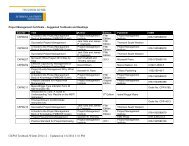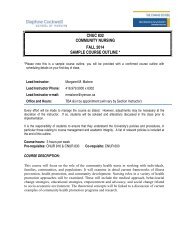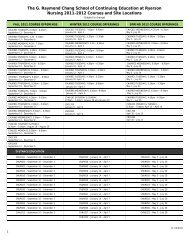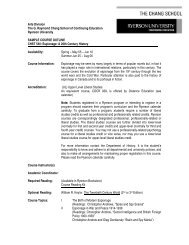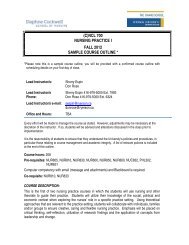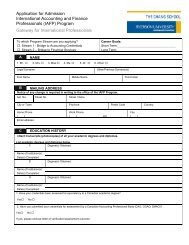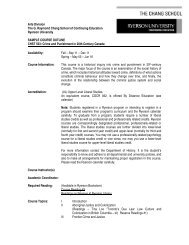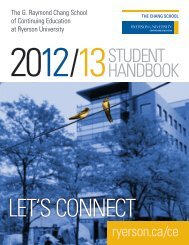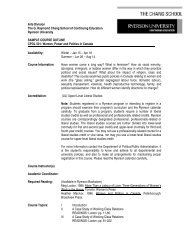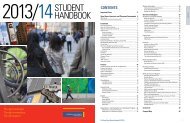Sample Classroom Course Outline - The Chang School - Ryerson ...
Sample Classroom Course Outline - The Chang School - Ryerson ...
Sample Classroom Course Outline - The Chang School - Ryerson ...
Create successful ePaper yourself
Turn your PDF publications into a flip-book with our unique Google optimized e-Paper software.
SAMPLE COURSE OUTLINECDFP 358Photography and the WebThis is a sample course outline only. It should not be used to plan assignments or purchase textbooks.A current version of the course outline will be provided by the instructor once the course begins.Every effort will be made to manage the course as stated. However, adjustments may be necessary at thediscretion of the instructor. If so, students will be advised and alterations discussed in the class prior toimplementation.It is the responsibility of students to ensure that they understand the University’s policies and procedures,in particular those relating to course management and academic integrity.COURSE DESCRIPTIONAn entry-level workshop course in which students will begin to acquire the basic skills related to thehardware and software required for web image production. Tools, applications, and creative methods inmaking photographic images in a screen-based environment using digital applications are covered.Emphasis is on cross-disciplinary instruction in an inter-media working environment. Students willinitially explore the context of time-based and moving-image systems, digital imaging, electronic sound,image formation, recording, and sequencing. (Equivalent to MPS 207.) Lab: 3 hoursCOURSE OBJECTIVE/LEARNING OUTCOMESAn introduction to the basic concepts and methods that underlie the use of computers in generating andprocessing images in the context of contemporary artistic practices in painting, photography, film, andvideo. This is an entry-level workshop course in which students will begin to acquire the basic skillsneeded to manage both the hardware and software required for computer mediated image production.Once this initiative is underway, students will then begin the process of understanding and evaluatinginput as a function of output, as it may apply to their own sense of personal artistic expression. Alsostudents will begin to assess the computer as both an artistic tool, working in conjunction with other moretraditional media, and, as a creative medium in its own right. as the student builds his/her skill level, aseries of exercises will be initiated that will allow the student to begin to address visual and compositionalissues such as photomontage, transformation, visualization, composite imaging, masking, sequencing andan introduction to screen based environments and web-based media within the context of how they maybe realized through a digitally mediated system.<strong>Sample</strong> <strong>Course</strong> <strong>Outline</strong> Winter 2013 Page 1 of 4Photography and the Web CDFP 358
COURSE CONTENT:Over the course of the next term, through a combination of lectures, demonstrations and practical 'HandsOn' exercises, the following subjects will be addressed:• Discussion of <strong>Course</strong> <strong>Outline</strong>, Overview & <strong>Course</strong> Expectations• Workspace issues / Setting yourself up for success• Image Editing / File management / Bridge• Introduction to ACR 6 / PhotoShop CS6 for Photographers & Web Design• Digital Post production techniques & effects• Image composition & creative techniques – Making Realistic composites• Image Processing / Batching / Actions• Image Sharpening• Issues of Image Conversion, Storage, and Transport (Screen vs Print)• Optimizing images for screen based environments• Creating an On-line presence / Domains / Search Engines / Blogs / Portable Media• Introduction to Dreamweaver & Flash Catalyst• All assignments will be outlined & discussed in class with demonstrations of required tools andexamples of relevant work pertaining to each assignment will be shownTEXTBOOK AND READING LISTS [[or “<strong>Course</strong> Materials; title may vary]]This is a sample course outline only. It should not be used to purchase textbooks. A current versionRecommended Texts:Real World Camera Raw With Adobe Photoshop CS6 by Jeff Schewe and Bruce FraserAdobe Photoshop CS6 <strong>Classroom</strong> in a BookAdobe Photoshop CS6 for Photographers: by Martin EveningAdobe Photoshop CS6 for Photographers: <strong>The</strong> Ultimate Workshop: by Martin Evening & Jeff ScheweReal World Adobe Photoshop CS6 for Photographers: by Conrad ChavezReal World Digital Photography: by Katrin Eismann, Sean Duggan, and Tim GreyAdobe Flash Catalyst <strong>Classroom</strong> in a BookFlash Catalyst CS5 Bible: by Rob HuddlestonAdobe Dreamweaver CS5 <strong>Classroom</strong> in a BookAdobe Dreamweaver CS5 Bible: by Joseph W. LoweryDreamweaver CS5: <strong>The</strong> Missing Manual: by David Sawyer McFarland<strong>Sample</strong> <strong>Course</strong> <strong>Outline</strong> Winter 2013 Page 2 of 4Photography and the Web CDFP 358
Older:Perception & Imaging by Richard D. Zakia<strong>The</strong> Reconfigured Eye by William J. MitchellOther books, papers, magazine and on-line resources may be required reading during the duration of theterm.COURSE STRUCTURE AND ORGANIZATIONThis is a sample course outline only. It should not be used to plan assignments. A current version ofthe course outline will be provided by the instructor once the course begins.Assignments:Assignments will be given as handouts in class and must be handed in for evaluation on or before the duedate. Assignments handed in late will receive a reduction of one letter grade per week.PLEASE NOTE: It is imperative that you observe all assignment deadlines. Not only will it result in areduced grade but if you get too far behind, you will find it very difficult, if not impossible, to catch up.METHOD AND SCHEDULE OF STUDENT EVALUATIONThis is a sample course outline only. It should not be used to plan assignments. A current version ofthe course outline will be provided by the instructor once the course begins.Assignment # 1 Photo Composite/Image Assembly 25%Assignment # 2 Panoramas 25%Assignment # 3 <strong>The</strong> Web / Photography Site / Blog 40%Attendance Participation 10%MISSED TERM WORK OR EXAMINATIONSStudents are expected to complete all assignments, tests, and exams within the time frames and by thedates indicated in this outline. Exemption or deferral of an assignment, term test, or final examination isonly permitted for a medical or personal emergency or due to religious observance. <strong>The</strong> instructor mustbe notified by e-mail prior to the due date or test/exam date, or as soon as possible after the date, and theappropriate documentation must be submitted. For absence on medical grounds, an official studentmedical certificate, downloaded from the <strong>Ryerson</strong> website athttp://www.ryerson.ca/senate/forms/medical.pdf or picked up from <strong>The</strong> <strong>Chang</strong> <strong>School</strong> at Heaslip House,<strong>Sample</strong> <strong>Course</strong> <strong>Outline</strong> Winter 2013 Page 3 of 4Photography and the Web CDFP 358
297 Victoria St., Main Floor, must be provided. For absence due to religious observance, visithttp://www.ryerson.ca/senate/forms/relobservforminstr.pdf to obtain and submit the required form.PLAGIARISM<strong>The</strong> <strong>Ryerson</strong> Student Code of Academic Conduct defines plagiarism and the sanctions against studentswho plagiarize. All <strong>Chang</strong> <strong>School</strong> students are strongly encouraged to go to the academic integritywebsite at www.ryerson.ca/academicintegrity and complete the tutorial on plagiarism.ACADEMIC INTEGRITY<strong>Ryerson</strong> University and <strong>The</strong> <strong>Chang</strong> <strong>School</strong> are committed to the principles of academic integrity asoutlined in the Student Code of Academic Conduct. Students are strongly encouraged to review thestudent guide to academic integrity, including penalties for misconduct, on the academic integrity websiteat www.ryerson.ca/academic integrity and the Student Code of Academic Conduct atwww.ryerson.ca/senate/policies.RYERSON STUDENT EMAILAll students in full and part-time graduate and undergraduate degree programs and all continuingeducation students are required to activate and maintain their <strong>Ryerson</strong> online identity atwww.ryerson.ca/accounts in order to regularly access <strong>Ryerson</strong>’s E-mail (Rmail), RAMSS, my.ryerson.caportal and learning system, and other systems by which they will receive official Universitycommunications.COURSE REPEATS:Senate GPA policy prevents students from taking a course more than three times. For complete GPApolicy see policy no. 46 at www.ryerson.ca/senate/policies.RYERSON ACADEMIC POLICIESFor more information on <strong>Ryerson</strong>’s academic policies, visit the Senate website atwww.ryerson.ca/senate/policies.<strong>Course</strong> Management Policy No. 145Student Code of Academic Conduct No. 60Student Code of Non-Academic Conduct No. 61Examination Policy No. 135Policy on Grading, Promotion, and Academic Standing Policy No. 46Undergraduate Academic Consideration and Appeals Policy No. 134Accommodation of Student Religious Observance Obligations Policy No. 150Academic Accommodation of Students with Disabilities Policy No. 159<strong>Sample</strong> <strong>Course</strong> <strong>Outline</strong> Winter 2013 Page 4 of 4Photography and the Web CDFP 358



